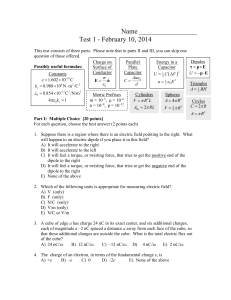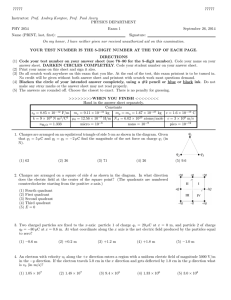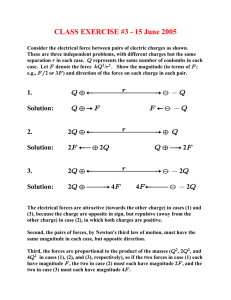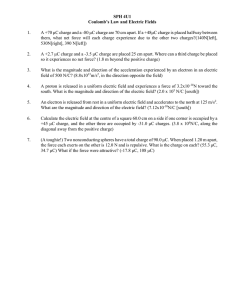Name _________________ Solutions to Test 1 - February 10, 2014
advertisement
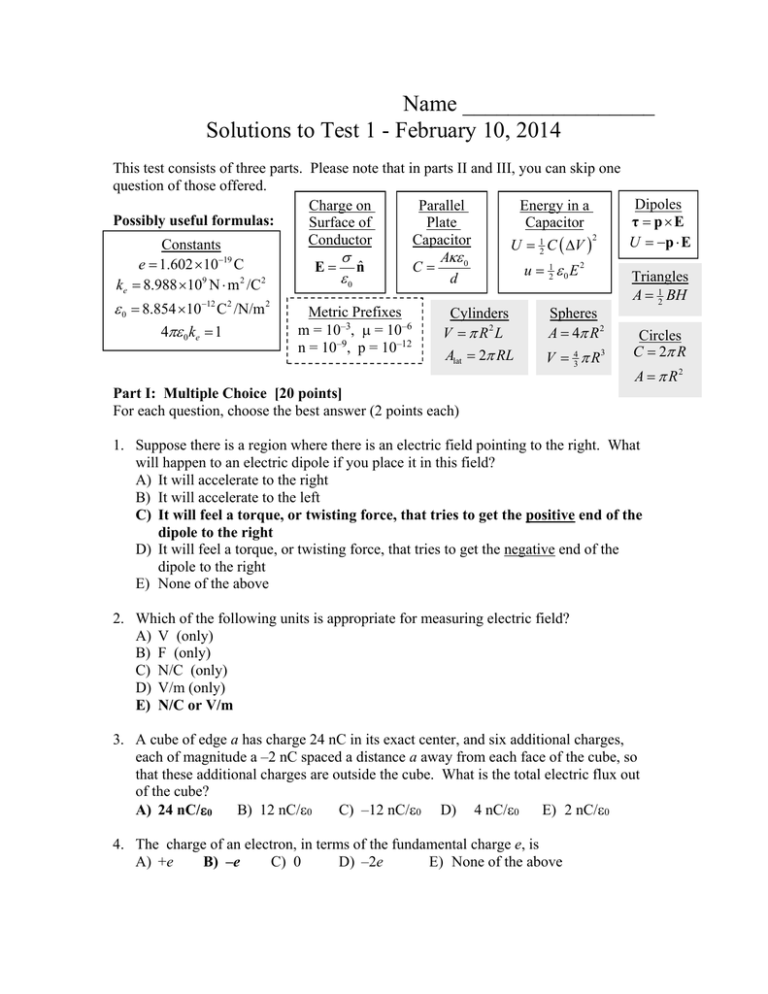
Name _________________ Solutions to Test 1 - February 10, 2014 This test consists of three parts. Please note that in parts II and III, you can skip one question of those offered. Charge on Parallel Energy in a Possibly useful formulas: Surface of Plate Capacitor 2 Conductor Capacitor Constants U 12 C V A 0 e 1.602 1019 C C E nˆ u 12 0 E 2 9 2 2 d 0 ke 8.988 10 N m /C 0 8.854 1012 C2 /N/m 2 4 0 ke 1 Metric Prefixes m = 10–3, = 10–6 n = 10–9, p = 10–12 Cylinders V R2 L Alat 2 RL Spheres A 4 R 2 V 43 R 3 Dipoles τ pE U p E Triangles A 12 BH Circles C 2 R A R2 Part I: Multiple Choice [20 points] For each question, choose the best answer (2 points each) 1. Suppose there is a region where there is an electric field pointing to the right. What will happen to an electric dipole if you place it in this field? A) It will accelerate to the right B) It will accelerate to the left C) It will feel a torque, or twisting force, that tries to get the positive end of the dipole to the right D) It will feel a torque, or twisting force, that tries to get the negative end of the dipole to the right E) None of the above 2. Which of the following units is appropriate for measuring electric field? A) V (only) B) F (only) C) N/C (only) D) V/m (only) E) N/C or V/m 3. A cube of edge a has charge 24 nC in its exact center, and six additional charges, each of magnitude a –2 nC spaced a distance a away from each face of the cube, so that these additional charges are outside the cube. What is the total electric flux out of the cube? B) 12 nC/0 C) –12 nC/0 D) 4 nC/0 E) 2 nC/0 A) 24 nC/0 4. The charge of an electron, in terms of the fundamental charge e, is A) +e B) –e C) 0 D) –2e E) None of the above 5. If a capacitor is a rectangular parallel plate capacitor of length L, width W, and separation D between the plates, with a material with dielectric constant between the plates, which of the following would not be a way to double the capacitance? A) Double B) Double L C) Double W D) Double D E) Actually, all of these would be a way to double the capacitance 6. For the simple circuit sketched at right, what can we say about the potential? A) Point A has a potential of 12.0 V A B) Point B has a potential of 12.0 V C) Point A has a potential 12.0 V higher than point B 12.0 V D) Point B has a potential 12.0 V higher than point A B E) None of the above 7. In the presence of electric fields, what happens to charges in an insulator? A) They can move freely over long distances B) They can move, but only a very small distance C) There are charges, but they can’t move at all D) Insulators do not contain charges E) It is impossible to have electric fields in an insulator 8. A plane of fixed area A is free to swing around at various angles compared to a background electric field. If we wanted to make the electric flux through the plane as negative as possible, which direction will the normal to the surface n point? A) Parallel to the electric field (pointing to the right) B) Perpendicular to the electric field, and pointing up n C) Perpendicular to the electric field, and pointing down D) Anti-parallel to the electric field (pointing to the left) E) None of the above 9. What does it mean when we say the electric field is a vector, while the electric potential is a scalar? A) The electric field has a direction, the electric potential does not B) The electric potential has a direction, the electric field does not C) The electric field can produce forces, the electric potential can not D) The electric potential can produce energies, the electric field can not E) I have no idea; please mark this one wrong 10. A negatively charged particle in a region of electric fields will be moving towards A) Wherever there’s free chocolate B) Regions of strong electric field C) Regions of weak electric field D) Regions of most negative electric potential E) Regions with most positive electric potential E Part II: Short answer [20 points] Choose two of the following questions and give a short answer (2-3 sentences) or brief sketch (10 points each). 11. Sketched at right are the electric potential lines around a pair of +4 kV charges A and B, with +6 kV the corresponding A voltage marked in. +5 kV Which of these charges is positive or negative, +3 kV and which of these +2 kV charges has a larger magnitude (hint – the potential half way in between is 0)? 0 kV –4 kV –6 kV B –5 kV –3 kV +1 kV –1 kV –2 kV The potential will be high (positive) near positive charges, and low (negative) near negative charges, and therefore, point A must have a positive charge, and point B a negative charge. Note that the spacing of the voltages is approximately the same around points A and B, suggesting that they have electric fields of the same magnitude. Perhaps most clearly, the potentials are exactly cancelling on the flat plane between these two points, indicating that the charges are the same magnitude. Hence they are equal and opposite charges. 12. Using the same diagram as for question 11, sketch in the electric field lines, clearly marking the direction of these lines. Sketch at least six lines, and make sure at least some of them go in or near the middle of the diagram. I recommend simply writing over the previous diagram. The electric field lines originate on the positive charge and flow to the negative charge. They will always run perpendicular to the equipotential lines. I have sketched them in the above diagram. 13. For the Superbowl, you have purchased a conducting piece of metal roughly in the shape of a football, as sketched at right. If you put charge on it, where will the electric field just outside the football going to be the largest? Where on the surface will the surface charge density be the largest? The electric field is largest at the most strongly curved parts, which for a football (or the object drawn) is near the ends. According to the formula 0 E nˆ , these will also be the places where the surface charge density is largest. Part III: Calculation: [60 points] Choose three of the following four questions and perform the indicated calculations (20 points each) 14. Point charges are arranged at the corners of a 30-60-90 triangle –60.0 C with hypotenuse 12.0 cm, with +20.0 C at the 60 angle and –60.0 C at the 30 angle, as illustrated at right. A third, unknown charge q is then placed at the right angle. 30 (a) Find the magnitude and direction of the electric field at the right angle from the other two charges The first thing we need to get is the distance from each of the charges to the point q. These are given by d1 12.0 cm cos 60 12.0 cm 6.00 cm d 2 12.0 cm sin 60 23 12.0 cm 6.00 3 cm . 1 2 60 +20.0 C 90 q We then calculate the electric field from each of these charges. We will keep careful track of the signs in each case, but we will check it intuitively. We have 8.988 109 N m 2 / C2 20.0 106 C ke q1 ˆ E1 2 rˆ i 4.99 107 ˆi N/C , 2 r 0.0600 m 8.988 109 N m 2 / C 2 60.0 106 C ke q2 ˆ ˆ E2 2 r j 4.99 107 ˆj N/C 2 r 0.0600 3 m The directions are correct, because the first one is to the right (away from the positive charge) and the second one is up (towards the negative charge). To get the magnitude, we take the square root of the sum of the squares of these two components. To get the direction, since it’s in the first quadrant (both components positive), we take the arctangent of the ratio. So we have 4.99 10 N/C 4.99 10 N/C 7.06 10 N/C , E arctan 4.99 10 4.99 10 arctan 1 45 . E Ex2 E y2 arctan E y 7 2 7 7 2 7 7 x (b) Calculate the magnitude and direction of the force on the charge q = 30.00nC. To get the magnitude, we just multiply the electric field times the magnitude of the charge. For negative charges the direction is reversed, which means adding 180 degrees to it. So we have: F 7.06 107 N/C 30.0 10 9 C 2.12 N , 225.0 . 15. A point charge of magnitude q = +2.00 pC lies at the exact center of a hollow conducting sphere of inner radius r = 2.00 cm and outer radius r = 4.00 cm. The conducting sphere itself has a net charge Q = –12.00 pC. (a) Find the electric field E at the following distances from the center: r = 1.00 cm, r = 3.00 cm, and r = 5.00 cm. point charge q conductor, charge Q 2 cm 4 cm hollow space The problem is spherically symmetrical, and we know from Gauss’s Law that for a spherically symmetric charge distribution, you simply include all the charge contained in a sphere of radius r, and calculate the field as if the charge is at the origin. For example, at r = 1 cm, only q lies inside that sphere, whereas at r = 5 cm, we have both charges q and Q. Finally at r = 3 cm, we are in the conductor, but electric fields always vanish in a conductor. So we have 8.988 109 N m 2 /C2 2.00 1012 C ke q E 1 cm 2 rˆ rˆ 179.8rˆ N/C , 2 r 0.01 m E 3 cm 0 , 8.988 109 N m 2 /C2 10.00 1012 C ke q Q E 5 cm rˆ rˆ 35.9rˆ N/C . 2 r2 0.05 m (b) Find the surface charge density , if any, on the interior surface of the sphere, and on the exterior surface of the sphere We know that at 3 cm, there is no electric field. By Gauss’s Law, this means that there must be no total charge inside this sphere. This implies that there must be exactly –2.00 pC spread over the interior surface of the conducting sphere. The remaining –10.00 pC must be on the exterior surface. Since surface charge density is charge divided by area, we have in out q q 2.00 pC 398 pC/m 2 , 2 2 A 4 r 4 0.02 m q q 10.00 pC 497 pC/m 2 . 2 2 A 4 r 4 0.04 m These quantities can also be computed by finding the electric field just inside or outside the sphere, and using 0 E nˆ . 16. The potential in a certain region of space is given by V Axy where A 5.20 106 V/m 2 (a) Find all three components of the electric field, Ex, Ey, and Ez, as functions of x and y. We simply use the formula Ex V V V Axy Ay , E y Axy Ax , Ez Axy 0 . x x y y z z (b) A particle of mass m = 3.00 g and charge q = 2.60 C is initially at rest at position x, y, z 1.00,1.00, 0.00 cm . Find the initial acceleration of this charge. The force is given by F qE , so we have Fx Ayq 5.20 106 V/m 2 0.0100 m 2.60 106 C 0.135 N , Fy Axq 5.20 106 V/m 2 0.0100 m 2.60 106 C 0.135 N , Fz 0q 0 . Written as a vector, we could have F .135ˆi .135ˆj N . To find the acceleration, we just rewrite F ma as a 1 1 .135 ˆi ˆj N= 45.1ˆi 45.1ˆj m/s 2 . F 3 m 3.00 10 kg Since we were not asked to calculate the magnitude or the direction, we are done, but if we want them, it is easily seen that the total magnitude is 63.7 m/s2 at a 45 degree angle. (c) The particle shortly thereafter finds itself at x, y, z 2.00, 2.00, 0.00 cm . How much did its potential energy change? The potential energy is just the electric potential times the charge. Therefore, U U f U i qV f qVi 2.60 106 C 5.20 106 V/m 2 0.0200 m 0.0200 m 2.60 106 C 5.20 106 V/m2 0.0100 m 0.0100 m 0.00135 V C 0.00541 V C 0.00406 J . The potential energy has decreased, which simply means that it is being converted into kinetic energy. In fact, you can easily work out the final speed by equating this to 12 mv 2 , and you then find the final speed is v 1.64 m/s . 17. Three capacitors, initially uncharged, are connected through two switches and to an 18.0 V battery, as sketched at right (a) Assume first that switch S2 is open. When switch S1 is closed, how much charge flows out of the battery, and what is the total energy in the system of capacitors? S1 S2 9.0 F 18.0 V 3.0 F 18.0 F Because the 9 and 18 F capacitors are disconnected from the circuit, this is essentially just a single capacitor with capacitance 3.0 F. We then simply use 2 Q C V and U 12 C V to get the charge and energy: Q C V 3.0 106 F 18.0 V 5.4 105 C 54.0 C , U 12 C V 12 3.0 106 F 18.0 V 4.86 104 J 486 J . 2 2 (b) Now, suppose instead that switch S2 is closed. When switch S1 is closed, how much charge flows out of the battery, and what is the total energy in the system of capacitors? This part actually has several steps. The first is to realize that the 9.0 F and 18.0 F capacitors are in series, and hence can be treated as a single capacitor. This capacitor has a capacitance that can be computed: 1 1 1 1 1 2 1 1 , C 6.0 F . C C1 C2 9.0 F 18.0 F 18.0 F 6.0 F The combined capacitor can be thought as being in the position of the 9.0 F capacitor, and the 18.0 F capacitor is replaced by a wire. It is now clear that the new 6.0 F capacitor and the 3.0 F capacitors are in series, so the capacitance is now C C1 C2 6.0 F 3.0 F 9.0 F . We then proceed as before, using the combined capacitance of the system: Q C V 9.0 106 F 18.0 V 1.62 104 C 162 C , U 12 C V 12 9.0 106 F 18.0 V 1.46 103 J 1.46 mJ . 2 2


